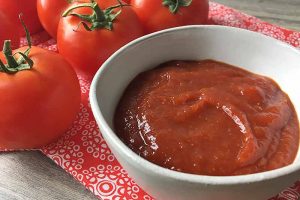When we consider our pantry needs, condiments are one thing we want to see when we open the refrigerator or cabinet door.
Ketchup

Did you know that ketchup (or catsup, both spellings are acceptable) was not tomato-based until the beginning of the 19th century? Ketchup is applied to almost any slightly sweet sauce that went over food. Today’s ketchup is made from vinegar, salt, tomato paste, water, sugar, and spices. And do you know why it can be so hard to get out of the bottle? It’s a “shear-thinning” fluid, meaning its tendency is to stick together until a force is applied to it, like tapping or shaking the bottle. While the salt and sugar content is high, so are the nutrient values, especially for anti-oxidants like lycopene.
Mustard
While ketchup doesn’t vary much from brand to brand, mustard can be all over the map from the slightly sweet yellow variety to super-hot, tear-inducing, sinus-clearing versions. It can be coarse or smooth, yellow or brown. It can contain horseradish, wasabi, or honey. Its irritation qualities are so high it was the basis for the earliest chemical weapons. It has also been used as a topical medicine. Mustard really refers to the mustard plant. Its seeds are used to make mustard sauce. There are many recipes for mustard, both commercial and homemade. Buy what you like, there’s no real winner here. No loser either.
Mayonnaise
This egg yolk, vinegar (or lemon juice), and oil emulsion is particularly popular in America as a sandwich spread, dip or salad dressing. If you’ve never tried it on French Fries, you’re missing a real treat. Like so many common cooking ingredients, the origin is lost in the mists of time. But most scholars believe the original recipe came from the town of Mahon in Spain. It was later adopted by French cooks which is the source of the current spelling. Mayonnaise is not hard to make, many cooks make their own. But it is a bit of a workout if you do it by hand. The drawback to this condiment is that it is high in fat. But lower-fat versions can be made by using extra virgin olive oil and a touch of mustard to add a bit of zing to the flavor.
Cooking Spray
This is one I should have mentioned earlier. I think I left it out because you can use a little cooking oil on a cloth or paper towel and do the same thing. But this is a lot faster, it’s affordable and worth having around. In addition to regular cooking spray, I also have one that’s butter-flavored and one with flour in it for baking.
Worcestershire Sauce
I’ve mentioned before that this is really English fish sauce. There it’s pronounced Wooster sauce. It takes its name from where it was developed, Worcester in England, by two pharmacists named Lee and Perrins. It is based on an ancient Roman fermented anchovy sauce called garum. In addition to being a great complement to meat, it’s a must for Caesar Salad dressing. I like to use it in eggs, stir-fries, and just about any non-white sauce I make. It just adds that little extra additional hit of umami.
Pickles
Some of you might want to skip this one, but I think pickles can be a good snack and good on sandwiches and in salads. But I can make no recommendations about what you should buy because it will depend on your own taste. My only warning is that if you are diabetic or trying to lose weight you should stay away from sweet or bread and butter style pickles because of the sugar content.
Tartar Sauce
Some people might think this is just mayonnaise with pickle relish in it. It’s a bit more than that, but is very similar and easy to make at home. It’s popular in the United States on fried fish. But it can also be used on chicken and steak. Again, if you’re not much of a fish eater, you can skip this.
Essential Canned Soups
Condensed Cream of Mushroom Soup. This is one I should have included in the canned goods article, but I forgot. The advantage of this is that it can be used for many dishes. It’s good for making gravy, braising meat, cooking chicken or making sauces for pasta, potatoes or rice. It might seem a bit cliche to use this for cooking instead of just for soup, but it really is a good starting point for many dishes. I suggest you buy low-fat, low sodium versions if you can.
Chicken Noodle Soup. When you’re sick, there’s simply nothing better. It reminds you of when Mommy took care of you when you were a kid. And the last thing you want to do when you’re sick is go out to buy soup or make it from scratch.


